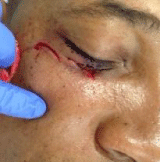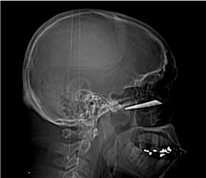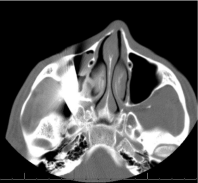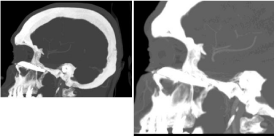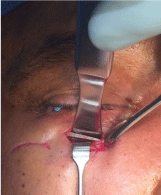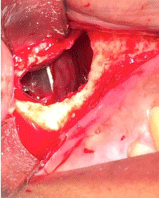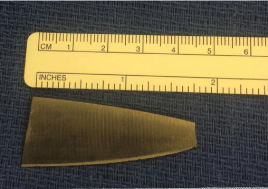Case Report
Penetrating Facial Injury with Retained Knife Blade: A Case Report
Jennifer Jones1, Marcello Guglielmi2 and Seth R. Brooks2*
1Department of Dentistry, Montefiore Medical Center, USA
2Department of Oral and Maxillofacial Surgery, University of Tennessee Medical Center, USA
*Corresponding author: Seth R. Brooks, Department of Oral and Maxillofacial Surgery, University of Tennessee Medical Center, Knoxville, Tennessee, USA
Published: 24 Apr, 2017
Cite this article as: Jones J, Guglielmi M, Brooks SR.
Penetrating Facial Injury with Retained
Knife Blade: A Case Report. Clin Surg.
2017; 2: 1411.
Abstract
Retained foreign bodies in the maxillofacial region are uncommon and rarely reported. In this case,
a report of a penetrating facial injury with a retained knife blade is presented. The importance of
thorough clinical and radiographic examinations in order to prevent the possibility of a missed or
failed diagnosis is discussed.
Keywords: Maxillofacial trauma; Retained foreign body; Penetrating injury
Introduction
Penetrating wounds in the maxillofacial region secondary to knife injuries are relatively
uncommon. Those with retained knife blades are even less commonly reported [1-5]. Review of the
literature commonly attributes these low rates of occurrence to the attempts to protect the face in
self defense [1,4,5]. Patients may often present with other knife-inflicted wounds to the hands and
thorax or abdomen [1].
Injuries to the maxillofacial region may be associated with serious complications and can be
potentially life threatening. In addition to possible facial bone fractures, important structures,
including the facial nerve, parotid gland and parotid duct, may be affected. The orbital region
is noted to be particularly vulnerable to injury and may result in more serious complications,
including impairment of ocular mobility, disturbances in vision or even complete loss of vision
[6-8]. As the structure of the orbit often directs penetrating objects towards the orbital apex, there is a high potential risk of intracranial penetration [4,9-11]. Intracranial involvement may lead to more serious, life-threatening sequelae, including hemorrhage, hematomas, pneumocephalus,
cerebrospinal fluid leakage, or even late complications such as meningitis or cerebral abscess [4,9-
11]. Accurate diagnosis and prompt, appropriate management is of utmost importance in the
management of penetrating facial injuries with retained foreign bodies.
Case Presentation
A 37-year-old male presented to the emergency department approximately twelve hours
after being involved in an altercation where he reports he was attempting to break up a fight. He
presented complaining of mild pain and numbness, as well as some bleeding from a cut on the right
face. He denied any loss of consciousness or changes in vision. On physical examination, the patient
was found to have multiple superficial lacerations of the face, neck, and thoracoabdominal region,
as well as a deep laceration of the right infraorbital region (Figure 1). Gross vision was normal, extraocular movements were intact, and his pupils were equally round and reactive to light. (The
patient was also evaluated by the ophthalmology department). Paresthesia was noted in the right V2
(maxillary branch) nerve distribution.
Radiological examination was performed. CT scans (without contrast) revealed a retained
foreign body (knife blade) in the right inferior orbit, extending into the right maxillary sinus and
pterygopalatine fossa (Figures 2 and 3). No evidence of intracranial involvement was noted. CT
Angiography was subsequently performed to evaluate for any vascular injury or proximity of the
retained blade to adjacent vasculature. The right internal maxillary artery was noted to be grossly
intact within the lateral aspect of the right pterygopalatine fossa with no contrast extravasation
suggestive of arterial injury (Figure 4).
The decision was made to remove the retained knife blade under general anesthesia. Both
interventional radiology and vascular surgery departments were made aware of the case and remained on standby in the event that arterial embolization or
surgical intervention were needed upon removal of the foreign
body. The margins of the existing laceration were retracted and
the blade immediately visualized (Figure 5). Adjacent infraorbital
rim periosteum was incised in order to increase visibility of the foreign body. Attention was then directed intraorally where a
maxillary vestibular approach was made. Subperiosteal dissection
was performed and a bony window was made in the anterior wall
of the right maxillary sinus in order to visualize the knife blade and
allow for additional surgical access, if needed (Figure 6). A 4.7 cm
knife blade was removed from the orbit via the entry wound using
gentle, controlled force, without bleeding or complications following
removal (Figure 7). The bony window was replaced and closure of
facial and intraoral sites completed.
An additional CT was obtained immediately post-operatively to
verify complete removal of the blade. At six weeks post-operatively,
the patient was noted to have continued right CN V2 paresthesia,
otherwise no visual complications or other sequelae were reported.
Figure 1
Figure 2
Figure 3
Figure 4
Figure 4
CT Angiogram – internal maxillary artery intact within
pterygopalatine fossa just inferior to blade.
Figure 5
Figure 6
Figure 7
Discussion
Retained foreign bodies following penetrating injury to the
maxillofacial region by a knife blade are fairly uncommon and rarely
reported. The largest report to date is that of Meer et al, with a recordbased
study of 24 cases of penetrating knife injuries with retention of
the blade [2]. Prior to that, the largest study with retained blades in
the maxillofacial region was that of Grobbelaar and Knottenbelt, with
a report of 11 patients [3]. Two cases were reported by Shinohara
et al. [1], and Cohen and Boyes-Varley presented 37 patients who
sustained penetrating injuries of the maxillofacial region with
retained foreign bodies, however only four of these involved a knife
blade [12]. In multiple cases, alcohol consumption or intoxication of
the patient was cited [1,2,8,11,13].
Initial emergency evaluation of a patient with penetrating knife
injury to the maxillofacial region should be thorough and systematic,
and often requires a multidisciplinary approach. Initial airway and
hemodynamic stabilization of the patient should be performed, as
well as assessment of damage to vital structures. Once the patient
is stable, appropriate laboratory and radiographic evaluations may
then be performed. Specialty consults should also be obtained, and
may include neurosurgery, ophthalmology, otolaryngology and
maxillofacial surgery, depending on the anatomical areas involved.
A detailed history of the mechanism of injury should be obtained,
from the patient, witnesses, or EMT, when possible. Penetrating
injuries may be overlooked in cases where an incomplete history of
the associated trauma is provided. Complete examination of the head
and neck region should be performed, with care taken to explore any
wounds that appear more than superficial. Patients may often present
with other knife wounds to the hands and thoraco-abdominal areas,
as seen in our case. In any patient sustaining deep knife wounds to the
maxillofacial area, imaging is warranted.
With any clinical evidence or suspicion of a retained foreign body,
radiographic evaluation should be performed. Typical radiographic
examinations would include plain film radiographs, CT, MRI, or
ultrasonography. At a minimum, two plain film radiographs taken
at right angles should be obtained in order to identify the location of
the foreign body in relation to vital structures [2,4,12,14]. Computed
tomography (CT) is usually the first line of imaging performed in
cases of deeper penetrating injuries, particularly when attempting
to detect metallic foreign bodies [4,15]. In cases where plain film
or CT may not be immediately available, ultrasonography has been
documented to be useful in foreign body detection [4,11,12,14].
Thorough knowledge of the vascular anatomy of the maxillofacial
region is especially important. If a foreign body, such as a retained
knife blade, is visualized on plain films or CT, angiography may
be indicated [2,13]. While catheter angiography is the standard of
care in the identification of vascular injuries, CT angiography may
alternately be used in the event traditional angiography is unavailable
[14]. Many major vessels are present in the maxillofacial region,
and damage to the vasculature should be initially suspected until
proven otherwise. Even if significant bleeding is not present on initial
examination, the foreign body may cause disruption of the vessel
walls, causing development of pseudoaneurysms. If disrupted during
foreign body removal, these may result in excessive, severe bleeding
[12]. The surgeon should always be mindful of these possibilities, and
angiography is of great value when planning to surgically retrieve the
foreign body. The surgeon may consider consulting interventional
radiology or vascular surgery in the event a problem should occur
during retrieval of the object and selective embolization or surgical
ligation of the associated vessels becomes necessary.
Surgical management of patients sustaining penetrating wounds
to the maxillofacial region with retained foreign bodies varies.
Treatment may depend on the composition or type of foreign body,
size, location of the object, and relationship to associated structures.
The ideal method of removing the retained knife blade is careful
extraction through the initial entrance wound, in a controlled setting
under general anesthesia [2,4,5,12]. Care should be taken to avoid
trauma to adjacent structures during withdrawal, especially if the
blade is serrated. Thorough exploration of the wound after foreign
body removal should then be performed with copious irrigation
of the site. When indicated, tetanus prophylaxis and appropriate
perioperative antibiotics should be administered.
As seen in this case, the initial history of the associated trauma is
often inaccurate or incomplete, especially when alcohol consumption
or intoxication is involved. Physical findings may not entirely
correlate with the reported nature of the injury or predisposing event.
In addition to a thorough physical examination, routine radiographic
examination (plain film radiography at minimum) is necessary in
all cases where injuries to the maxillofacial region are not clearly
superficial or the history of the inciting event is unclear.
References
- Shinohara EH, Heringer L, de Carvalho Junior JP. Impacted knife injuries in the maxillofacial region: a report of 2 cases. J Oral MaxillofacSurg. 2001;59(10):1221-3.
- Meer M, Siddiqi A, Morkel JA, Janse van Rensburg P, Zafar S. Knife inflicted penetrating injuries of the maxillofacial region: A descriptive, record-based study. Injury. 2010;41(1):77-81.
- Grobbelaar A, Knottenbelt JD. Retained knife blades in stab wounds of the face: is simple withdrawal safe? Injury. 1991;22(1):29-31.
- Santos T, Avelar R, Melo A, de Moraes HH, Dourado E. Current approach in the management of patients with foreign bodies in the maxillofacial Region. J Oral Maxillofac Surg. 2011;69(9):2376-82.
- Hudson DA. Impacted knife injuries of the face. Br J PlastSurg. 1992;45(3):222-24.
- Ballim S, Gundry B, Mahomed S, Visser L. Intra-orbital knife blade foreign body: A case series. S Afr J Surg. 2013;51(4):134-37.
- Ho VH, Wilson MW, Fleming JC, Haik, BG. Retained intraorbital metallic foreign bodies. Ophthal Plast Reconstr Surg. 2004; 20(3):232-36.
- Fulcher TP, McNab AA, Sullivan TJ. Clinical features and management of intraorbital foreign bodies. Ophthalmology. 2002;109(3):494-00.
- Shelsta H, Bilyk J, Rubin P, Penne RB, Carrasco JR. Wooden intraorbital foreign body injuries: clinical characteristics and outcomes of 23 patients. Ophthal Plast Reconstr Surg. 2010;26(4):238-44.
- Rana MA, Alharthy A, Aletreby WT, Huwait B, Kulshrestha A. Transorbital Stab Injury with Retained Knife: A Narrow Escape. Case Reports in Critical Care. 2014.
- Nasr A, Haik B, Fleming JC, Al-Hussain HM, Karcioglu ZA. Penetrating orbital injury with organic foreign bodies. Ophthalmology. 1999;106 (3):523-32.
- Cohen M, Boyes-Varley G. Penetrating injuries to the maxillofacial region. J Oral Maxillofac Surg. 1986; 44(3):197-202.
- Van Lierop AC, Raynham O, Basson O, Lubbe DE. Retained knife baldes in the ear, nose and throat: three cases. J. Laryngol Otol. 2009;123(3):351-55.
- Tabariai E, Sandbu S, Alexander G, Townsend R, Julian R, Bell G, et al. Management of facial penetrating injury – a case report. J Oral Maxillofac Surg. 2010;68(1):182-87.
- Kumar GBA, Dhupar V, Akkara F, Praveen Kumar S. Foreign body in the orbital floor: a case report. J Maxillofac Oral Surg. 2015;14(3):832-35.

